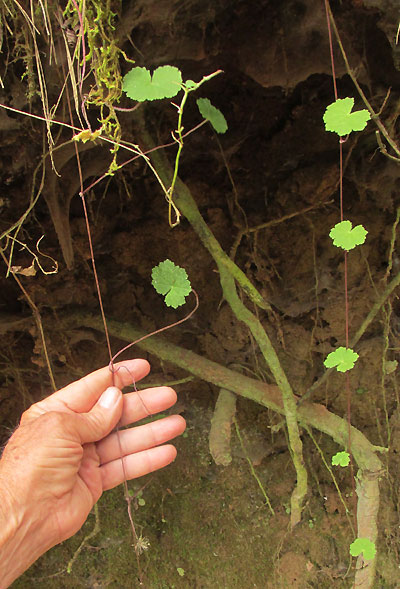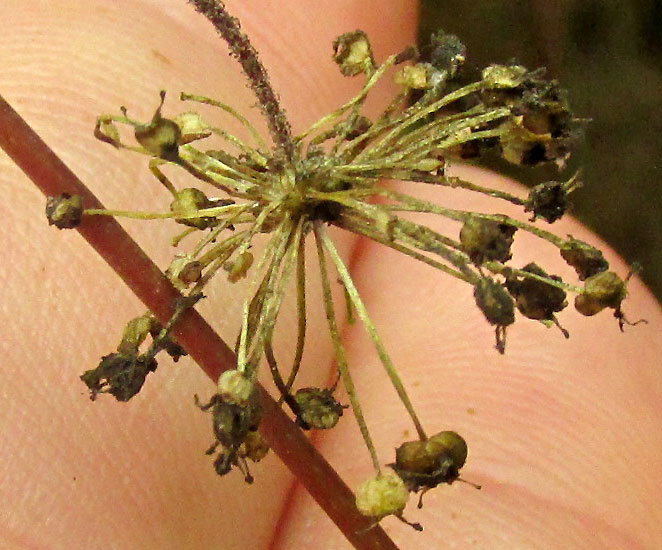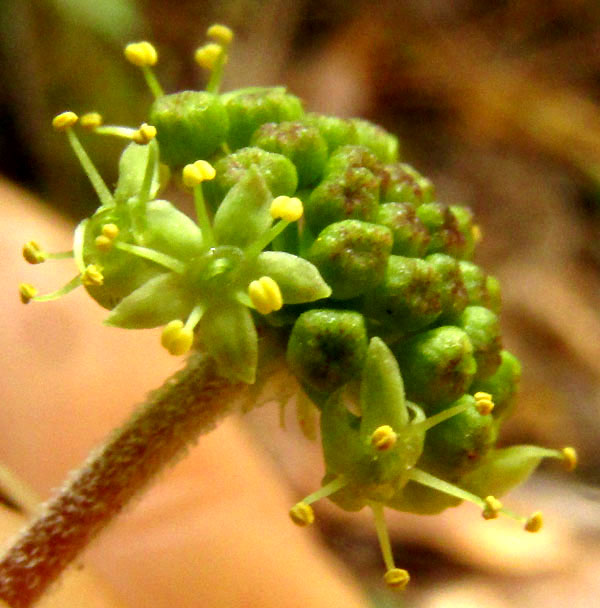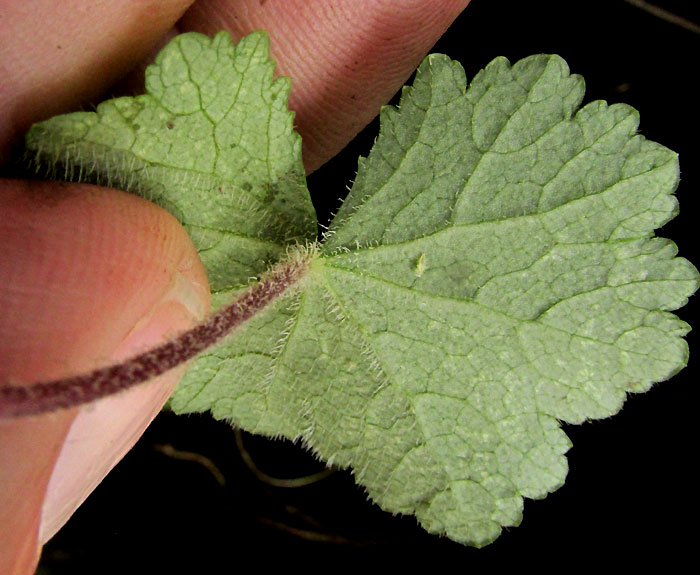Excerpts from Jim Conrad's
Naturalist Newsletter
entry from field notes dated January 19, 2023, taken along steep, one-lane gravel road ascending forested, northeast-facing mountain slope, elevation ±2,380m (7600 ft); bedrock of Cretaceous limestone; on the south side of Pinal de Amoles, Querétaro state, MÉXICO, (N21.134°, W99.629°)
PENNYWORT

Dangling from a small overhang atop a roadcut beside the trail, in a spot where usually there's little or no direct sunlight beneath the pine trees, the above plant was unlike anything I'd ever seen. Fortunately, the little plant bore a fruiting head, not in the best condition, but at least affording a look at its structure:

On a long, slender stem, or peduncle, a cluster of mature fruits was gathered into an umbel-type infructescence, an umbel described as a flower cluster in which the flower stalks, or pedicels, are of nearly equal length and arise from a common center. The two main plant families to think of when you see such an umbel are the Ginseng Family, the Araliaceae, and the Parsley or Carrot Family, the Apiaceae. A closer look at the fruits confirmed this impression:

All these fruits appear to be in bad shape, maybe most or all aborted because of the failure of the last rainy season and the current drought. Still, you can see what appear to be two styles atop each fruit. Also, what seem to be blackened, dried-up remains of petals arise atop the fruits, not below them, meaning that the flowers' ovaries are inferior. The fruits are schizocarps, meaning that they're dry, not fleshy, and that they split into single-seeded parts when mature. That's all perfectly acceptable for the Ginseng and Parsley Families. However, especially the Parsley Family is a big one, and the ID of this plant still was uncertain. I was lucky that down the road another plant just like the above was producing a flowering head:

Five petals, five stamens, and at the base of the two styles there's a green, flattish disc called a stylopodium, typical of our two suspect families. In the above picture, in the flower most in the center, two immature styles appear a little paler than the surrounding stylopodium, indicating that the flowers' male parts mature before the female, reducing the possibility of self-pollination. Now we have good field marks, but there's still the leaf:

Looking into both the Parsley Family and the Ginseng Family, our distinctive plant with its simple umbels and simple (undivided), roundish leaves with short, irregular teeth, quickly revealed itself as HYDROCOTYLE MEXICANA.
Most currently available floras assign the genus Hydrocotyle to the Parsley Family, but at this writing, though it's regarded as a kind of link between the two families, Hydrocotyle is placed in the Ginseng Family, the Araliaceae. All 100 or so species in the genus Hydrocotyle can be known in English as Pennyworts.
However, our Hydrocotyle mexicana occurs only in Spanish-speaking territory, from the uplands of central Mexico south through Central America into northwestern South America. Our species appears to be a little unusual in the genus by being so hairy, with many stiff hairs lying close to the surfaces of stems, petioles and peduncles -- hairs that are appressed-strigose. Hydrocotyle species in general are thought of as inhabiting wet to damp places. Our plant's environment certainly wasn't wet or damp, but it was deeply shaded so that at least during the rainy season it must be somewhat damp. Thick clumps of moss grew on the ground where our plant was rooted.
Pennyworts in general often appear in great masses, especially in marshes and other wet or moist places. Also they are regarded as edible, so there's culinary possibility here. There's little information available about Hydrocotyle mexicana, other than where it's been collected. After seeing pennywort species so frequently described as aquatic and marsh-loving, here we can at least say that sometimes they grow in very dry spots, though they may appear to suffer greatly if it hasn't rained for a long time.